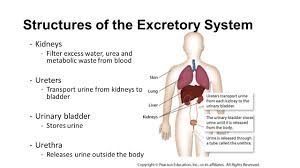Excretory system in the body process शरीर में उत्सर्जन तंत्र प्रक्रिया
Computer 0 Comments
Excretory system in the body process शरीर में उत्सर्जन तंत्र प्रक्रिया
Excretory organ in the body – bowel, skin, lung, kidney, liver etc
शरीर में उत्सर्जी अंग – आंत्र, त्वचा, फेफड़े, वृक्क, यकृत आदि।
यकृत (Liver)
Urea is produced in the liver. It erupted through the kidney unusable Hakor the pigment in bile salts, bile juice with changing intestinal (digestive tract) from where they are transported to the side of the stool to exit.
यकृत में यूरिया का निर्माण होता है। ओर यह वृक्क के माध्यम से उत्सर्जीत होता है।ओर यह अनुपयोगी वर्णक पित्त लवणों में बदल कर पित्त रस के साथ आंत्र(आहार नाल) में पहुंच जाते है ओर जहां से वे मल के साथ बाहर निकल जाते है।
वृक्क (Renal)
Its shape – is similar to the size of bean seeds.
इसकी आकृति – सेम के बीज के आकार के समान होती है।
इसको चार भागो मे बाटा गया है। (It is divided into four parts.)
It is a pair of kidney.
It is a couple of Mutrwahini.
It is a vesica.
It is a Mutradwar.
Its outer surface is called Uttonuma.
Awatlnuma vigilant to its internal call
It Kidni right (renal) left Kidni is found below. And a pair of concave surface renal artery, renal vein and a pair – each have their own respective Mutrwahini renal (Kidni) million nephrons are found. And structural and functional unit of the emission is called.
That the total number of nephrons in the human body – 20 million lives.
Filtered part of blood in it – is called Glomeruls Filtret.
It’s from all of the nephron Acnit urine collection vessel is called.
It the son – 96% water, 2% Yuria, 2% Yurik acid is found.
It PH – 6-8 is mildly acidic.
Light yellow color is due to the Yurokrom.
इसमे एक जोड़ी वृक्क की होती है।
इसमे एक जोड़ी मुत्रवाहिनी की होती है।
इसमे एक मुत्राशय होता है।
इसमे एक मुत्रद्वार होता है।
इसके बाहरी सतह को उत्तनुमा कहते है।
इसके आन्तरिक सतक को अवतलनुमा कहते है।
इसमे दांयी किड़नी(वृक्क) बांयी किड़नी से नीचे पाई जाती है। और इसकी अवतल सतह से एक जोड़ी वृक्कीय धमनी, एक जोड़ी वृक्कीय शिरा और अपनी – अपनी मुत्रवाहिनी सम्बन्धित रहती है।और प्रत्येक वृक्क (किड़नी)में दस लाख नेफ्रोन पाये जाते है। और जो उत्सर्जन की संरचनात्मक व क्रियात्मक ईकाई कहलाती है।
मानव शरीर में कुल नेफ्रोन कि सख्या – 20 लाख रहती है।
इसमे रूधिर का छनित भाग – ग्लोमेरूलस फिल्ट्रेट कहलाती है।
इसमे समस्त नेफ्रोन की संग्रह वाहिनियों से आया हुआ अछनित मूत्र कहलाता है।
इसमे मुत्र – 96 % जल, 2 % युरिया, 2 % युरिक एसिड पाये जाते है।
इसमे PH – 6-8 हल्का अम्लीय होता है।
इसका युरोक्रोम के कारण हल्का पिला रंग होता है।
त्वचा (Skin)
Yuria unnecessary salts from the skin in the human body and are excreted as Pasine.
मानव शरीर में त्वचा से भी अनावश्यक लवण व युरिया पसिने के रूप में निकलते है।
आहार नाल (Digestive tract)
Pcit food waste in the digestive tract of the human body part is stored as stool in the rectum मानव शरीर में आहार नाल में पचित भोजन का अपशिष्ट भाग मल के रूप में मलाशय में एकत्रित हो जाता है।
फेफड़े (Lungs)
Lung carbon oxide in the human body emits.
मानव शरीर में फेफड़े कार्बनडाइ आक्साइड का उत्सर्जन करता है।
शरीर में उत्सर्जन की प्रकृति के आधार पर जन्तुओं को तीन भागो मे बाटा गया है (Depending on the nature of emissions in the body of animals is divided into three parts.)
Human – Ureotelic – Yuria emission process is found.
Birds Square – Yurikoletik – emission process of uric acid is found.
Water body – Amonotelik – ammonia emission process is found
मानव – युरियोटेलिक – युरिया उत्सर्जन प्रक्रिया पाई जाती है।
पक्षी वर्ग – युरिकोलेटिक – यूरिक अम्ल का उत्सर्जन प्रक्रिया पाई जाती है।
जलीय जीव – अमोनोटेलिक – अमोनिया का उत्सर्जन प्रक्रिया पाई जाती है।




